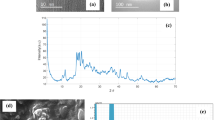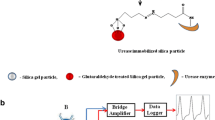Abstract
The urease enzyme of Helicobacter pylori was isolated from biopsy sample obtained from antrum big curvature cell extracts. A new urea biosensor was prepared by immobilizing urease enzyme isolated from Helicobacter pylori on poly(vinylchloride) (PVC) ammonium membrane electrode by using nonactine as an ammonium ionophore. The effect of pH, buffer concentration, and temperature for the biosensor prepared with urease from H. pylori were obtained as 6.0, 5 mM, and 25 °C, respectively. We also investigated urease concentration, stirring rate, and enzyme immobilization procedures in response to urea of the enzyme electrode. The linear working range of the biosensor extends from 1 × 10−5 to 1 × 10−2 M and they showed an apparent Nernstian response within this range. Urea enzyme electrodes prepared with urease enzymes obtained from H. pylori and Jack bean based on PVC membrane ammonium-selective electrode showed very good analytical parameters: high sensitivity, dynamic stability over 2 months with less decrease of sensitivity, response time 1–2 min. The analytical characteristics were investigated and were compared those of the urea biosensor prepared with urease enzyme isolated from Jack bean prepared at the same conditions. It was observed that rapid determinations of human serum urea amounts were also made possible with both biosensors.





Similar content being viewed by others
References
Dunn, B. E., Campbell, G. P., Perez-Perez, G. I., & Blaser, M. J. (1990). Purification and characterization of urease from Helicobacter pylori. The Journal of Biological Chemistry, 265(16), 9464–9469.
McGee, D. J., May, C. A., Garner, R. M., Himpsl, J. M., & Mobley, H. L. T. (1999). Isolation of Helicobacter pylori genes that modulate urease activity. Journal of Bacteriology, 181(8), 2477–2484.
Karakus, E., Pekyardımci, S., & Kılıc, E. (2005). Urea biosensor based on PVC membrane containing palmitic acid. Artificial Cells Blood Substitutes and Biotechnology, 33, 329.
Eggenstein, C., Borchardt, M., Diekmann, C., Grundig, B., Dumschat, C., Cammann, K., et al. (1999). A disposable biosensor for urea determination in blood based on an ammonium-sensitive transducer. Biosensors and Bioelectronics, 14, 33.
Liu, D., Ge, K., Cheng, K., Nie, L., & Yao, S. (1995). Clinical analysis of urea in human blood by coupling a surface acoustic wave sensor with urease extracted from pumpkin seeds. Analytical Chimica Acta, 307, 61.
Xie, X., Suleiman, A. A., & Guilbault, G. G. (1991). Determination of urea in serum by a fiber-optic fluorescence biosensor. Talanta, 38, 1197.
Adeloju, S. B., Shaw, S. J., & Wallace, G. G. (1993). Polypyrrole-based potentiometric biosensor for urea part 1. Incorporation of urease. Analytical Chimica Acta, 281, 611.
Liu, D., Meyerhoff, M. E., Goldberg, H. D., & Brown, R. B. (1993). Potentiometric ion and bioselective electrodes based on asymmetric polyurethane membranes. Analytical Chimica Acta, 274, 37.
Chen, K., Liu, D., Nie, L., & Yao, S. (1994). Determination of urea in urine using a conductivity cell with surface acoustic wave resonator-based measurement circuit. Talanta, 41, 2195.
Sangodkar, H., Sukeerthi, S., Srinivasa, R. S., Lal, R., & Contractor, A. Q. A. (1996). Biosensor array based on polyaniline. Analytical Chemistry, 68, 779.
Adams, R. E., & Carr, P. W. (1978). Coulometric flow analyzer for use with immobilized enzyme reactors. Analytical Chemistry, 50, 944.
Adeloju, S. B., Shaw, S. J., & Wallace, G. G. (1996). Polypyrrole-based amperometric flow injection biosensor for urea. Analytica Chimica Acta, 323, 107.
Ho, W. O., Krause, S., McNeil, C. J., Pritchard, J. A., Armstrong, R. D., Athey, D., et al. (1999). Electrochemical sensor for measurement of urea and creatinine in serum based on ac impedance measurement of enzyme-catalyzed polymer transformation. Analytical Chemistry, 71, 1940.
Gupta, B., Singh, S., Mohan, S., & Prakash, R. (2010). Urea Biosensor Based on Conducting Polymer Transducers. Biosensors, Book edited by: Pier Andrea Serra, February 2010, INTECH, Croatia. pp. 302
Rick, W. (1990). Klinishe Chemie und Mikroskopie (pp. 245–247). Berlin: Springer.
Ruzicka, J., Hansen, E. H., Ghose, A. K., & Mottola, H. A. (1979). Enzyme determination of urea in serum based on pH measurement with the flow injection method. Analytical Chemistry, 51, 199–203.
Vadgama, P. M., Alberti, K. G. M. M., & Covington, A. K. (1982). Determination of urea in blood plasma by enzyme-pH electrode. Analytica Chimica Acta, 136, 403–406.
Miyahara, Y., Moriizumi, T., & Ichimura, K. (1985). Integrated enzyme FETs for simultaneous determination of urea and glucose. Sensors and Actuators, 7, 1–10.
Karube, I., Tamiya, E., & Dicks, J. M. (1986). A microsensor for urea based on an ion-selective field effect transistor. Analytica Chimica Acta, 185, 195–200.
Hamann, H., Kühn, M., Böttcher, N., & Scheller, F. (1986). Enzyme sensor system for potentiometric urea determination in serum and milk. Journal of Electroanalytical Chemistry, 209, 69–79.
Guilbault, G. G., & Montalvo, J. G. (1970). An enzyme electrode for the substrate urea. Journal of the American Chemical Society, 92, 2533–2538.
Campanella, L., Mazzei, F., Sammartino, M. P., & Tomassetti, M. (1990). New enzyme sensors for urea and creatinine analysis. Bioelectrochemistry and Bioenergetics, 23, 195–202.
Walcerz, I., Koncki, R., Leszczynska, E., Salamonowicz, B., & Glab, S. (1996). Enzyme biosensors for urea determination based on an ionophore free membrane electrode. Analytical Letters, 29(11), 1939–1953.
Koncki, R., Walcerz, I., Ruckruh, F., & Glab, S. (1996). Bienzymatic potentiometric electrodes for creatine and L-arginine determination. Analytica Chimica Acta, 333, 215–222.
Schneider, J., Gründig, B., Renneberg, R., Cammann, K., Madaras, M. B., Buck, R. P., et al. (1996). Hydrogel matrix for three enzyme entrapment in creatine/creatinine amperometric biosensing. Analytica Chimica Acta, 325, 161–167.
Jasnowska, J., Ligaj, M., Stupnicka, B., & Filipiak, M. (2004). DNA sensor for o-dianisidine. Bioelectrochemistry, 64, 85–90.
Korenbrot, J. I., Perry, R., & Copenhagen, D. R. (1987). Development and characterization of a polymer gel with an immobilized enzyme to measure l-glutamate. Analytical Biochemistry, 161, 187–199.
Berthelot, MPE (1859). Berthelot’s reaction mechanism. Report Chim. Appl. 2884.
Magalhaes, J. M. C. S., & Machado, A. A. S. C. (1998). Urea potentiometric biosensor based on urease immobilized on chitosan membreanes. Talanta, 47, 183–191.
Alqasaimeh, M. S., Heng, L., & Ahmad, M. (2007). A urea biosensor from stacked sol-gel films with ımmobilized Nile Blue chromoionophore and urease enzyme. Sensors, 7, 2251–2262.
Karakuş, E., Pekyardımcı, Ş., & Kılıç, E. (2006). Potentiometric bienzymatic biosensor based on PVC membrane containing palmitic acid for determination of creatine. Process Biochemistry, 41(6), 1371–1377.
Koncki, R., Kopczewska, E., & Glab, S. (1994). Comparison of pH-membrane enzyme electrode for urea with covalently bound enzyme. Analytical Letters, 27(3), 475–486.
Koncki, R., Chudvick, A., & Walcerz, I. (1999). Urea determination using pH-enzyme electrode. Journal of Pharmaceutical and Biomedical Analysis, 21, 51–57.
Butt, S. B., & Camman, K. (1992). Enzyme urea biosensor based on a modified potentiometric PVC-nonactin membrane electrode for assay of urea in blood. Analytical Letters, 25(9), 1597–1615.
Walcerz, I., Koncki, R., Leszczynska, E., & Glab, S. (1995). Enzyme biosensors for urea determination based on an ionophore free pH membrane electrode. Analytica Chimica Acta, 315, 289–296.
Tinkilic, N., Cubuk, O., & Isildak, I. (2002). Glucose and urea biosensor based on all solid-state PVC-NH2 membrane electrodes. Analytica Chimica Acta, 452, 29–34.
Lakard, B., Herlem, G., Lakard, S., Antoniou, A., & Fahys, B. (2004). Urea potentiometric biosensor based on modified electrodes with urease immobilized on polyethylenimine films. Biosensors and Bioelectronics, 19, 1641–1647.
Jha, S. K., Topkar, A., & D’Souza, S. F. (2008). Development of potentiometric urea biosensor based on urease immobilized in PVA-PAA composite matrix for estimation of blood urea nitrogen (BUN). Journal of Biochemical and Biophysical Methods, 70, 1145–1150.
Ru-Qin, Y., Zong-Rang, Z., & Guo-Li, S. (2000). Potentiometric sensors: Aspects of the recent development. Sensors and Actuators B, 65, 150–153.
Umezawa, Y., Bühlmann, P., Umezawa, K., Tohda, K., & Amemiya, S. (2000). Pure and Applied Chemistry, 72(10), 1851–2082.
Acknowledgment
We gratefully acknowledge for the financial support of Yildiz Technical University Scientific Research Project Coordination (project no.: 28-01-02-15) and Rentek Dialysis Center for obtaining human serum samples.
Author information
Authors and Affiliations
Corresponding author
Rights and permissions
About this article
Cite this article
Dindar, B., Karakuş, E. & Abasıyanık, F. New Urea Biosensor Based on Urease Enzyme Obtained from Helycobacter pylori . Appl Biochem Biotechnol 165, 1308–1321 (2011). https://doi.org/10.1007/s12010-011-9348-2
Received:
Accepted:
Published:
Issue Date:
DOI: https://doi.org/10.1007/s12010-011-9348-2




